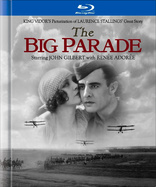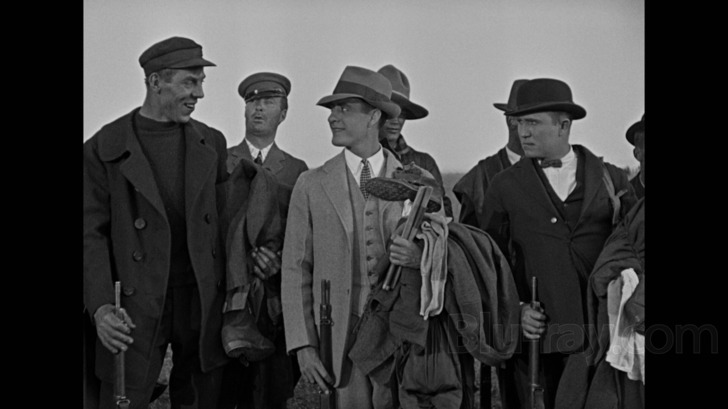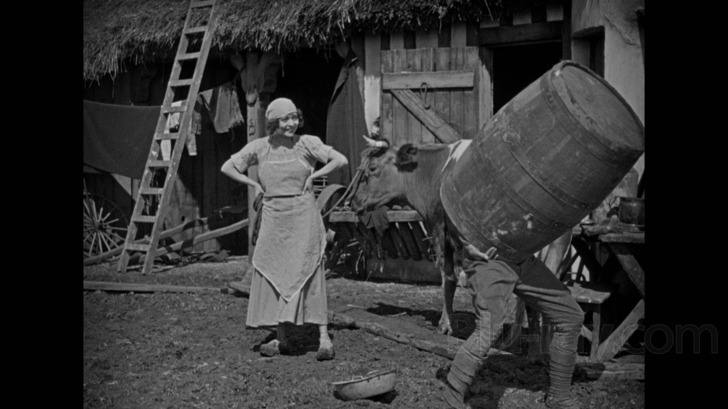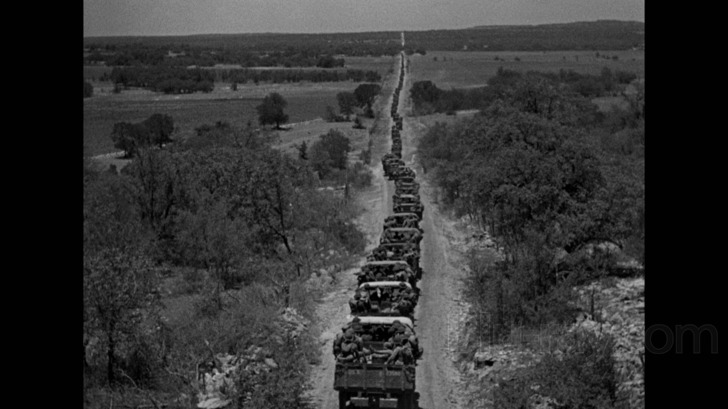The Big Parade Blu-ray Movie
HomeThe Big Parade Blu-ray Movie 
Warner Bros. | 1925 | 151 min | Not rated | Oct 01, 2013
Movie rating
7.9 | / 10 |
Blu-ray rating
| Users | 5.0 | |
| Reviewer | 4.5 | |
| Overall | 4.5 |
Overview
The Big Parade (1925)
The idle son of a rich businessman joins the army when the U.S.A. enters World War One. He is sent to France, where he becomes friends with two working-class soldiers. He also falls in love with a Frenchwoman, but has to leave her to move to the frontline.
Starring: John Gilbert (I), Renée Adorée, Hobart Bosworth, Claire McDowell, Claire Adams (I)Director: King Vidor, George W. Hill
| Drama | Uncertain |
| War | Uncertain |
Specifications
Video
Video codec: MPEG-4 AVC
Video resolution: 1080p
Aspect ratio: 1.37:1
Original aspect ratio: 1.33:1
Audio
English: DTS-HD Master Audio 2.0 (48kHz, 24-bit)
Subtitles
English SDH, French, Spanish
Discs
50GB Blu-ray Disc
Single disc (1 BD)
Playback
Region free
Review
Rating summary
| Movie | 5.0 | |
| Video | 4.5 | |
| Audio | 4.0 | |
| Extras | 3.5 | |
| Overall | 4.5 |
The Big Parade Blu-ray Movie Review
The Big Blu-ray
Reviewed by Michael Reuben October 5, 2013The "big parade" of the title—a long line of trucks carrying soldiers and guns toward the battlefront in what was then called "The Great War"—does not appear until ninety minutes into director King Vidor's 1925 silent epic, but you can feel its inevitable approach from early on. Vidor had told MGM's legendary head of production, Irving Thalberg, that he was tired of making films that came and went in a week. He wanted to direct a picture that would last. With The Big Parade, which played for nearly two years and became the highest grossing silent film in MGM's history, Vidor achieved his goal and solidified his stature in the first rank of filmmakers. In the accompanying supplements, film historians Jeffrey Vance and Kevin Brownlow make a compelling case that Vidor was the true successor to D.W. Griffith. As Vance says, if Griffith made film into an art form, it was Vidor who brought it into the 20th Century. And what subject could be more appropriate for establishing a 20th Century way of seeing than World War I? More than any specific date on the calendar, that bloody conflict drew a clear dividing line between the 19th Century's Eurocentric colonialism and the new era's international scene in which America was beginning to play a larger role and wars would be waged on a scale heretofore unthinkable. Vidor disliked the pageantry of the war films he had seen up until that point. He wanted to tell a story from a common soldier's point of view, something more visceral and less overtly heroic. The Big Parade is the first American war film that doesn't celebrate war itself, and its influence in that respect has been incalculable. Entire sequences in the Oscar-winning All Quiet on the Western Front (1930) owe their staging to Vidor's earlier film. Upon discovering that author Laurence Stallings' stage play What Price Glory had already been optioned (Raoul Walsh would eventually direct it for Fox), Vidor persuaded Thalberg to hire Stallings to supply an original story for The Big Parade, which was then dramatized by Vidor and screenwriter Harry Behn. The story grew even larger after Thalberg saw Vidor's first cut, realized the power of what the director had achieved and ordered additional scenes.

The central figure of The Big Parade is a pampered and idle young man, Jim Apperson (silent film star John Gilbert, in what he personally considered his greatest performance). Overshadowed by his more industrious brother, Harry (Robert Ober), who works in the family business, Jim endures the disapproval of his father (Hobart Bosworth), which is made tolerable by the indulgence of his mother (Claire McDowell). His heart belongs to a longtime neighbor, Justyn Reed (Claire Adams)—or so he thinks. But then the U.S. enters the long-running conflict in Europe, and everything changes. Transported by a fit of patriotic enthusiasm, Jim joins his school chums and enlists. Justyn swoons. Mr. Apperson is uncharacteristically proud of his wayward son. Jim marches off to war in a haze of enthusiasm. Of course, he doesn't go alone. The film gives Jim two companions from other walks of life. Slim Jensen (Karl Dane) is a welder who can't wait to get into action. Lanky, a champion spitter who always hits his target, with a face made for clowning, Slim is the film's comic sidekick in its first half. The other companion is Bull O'Hara (Tim O'Brien), a stocky bartender whose blowhard temperament suits him perfectly when he is promoted to corporal. This unlikely trio of comrades, a classic example of the true democracy imposed by war's hazard and privation, is melded into a unit in basic training, then shipped to France, where they spend much time waiting, waiting, waiting in the farming village of Champillon. Much of the first half of The Big Parade is played for laughs, as the soldiers in Jim's unit accommodate themselves to wading through mud and muck, sleeping in haylofts, fighting off lice and doing laundry in streams. Vidor stages a Chaplinesque scene of physical hijinks when Jim is chosen to obtain a barrel for building a makeshift shower and returns with it over his head, covering his upper body, his vision limited to the small circle of light where he can peer out of the barrel's bunghole. It is through this "peephole" that Jim encounters Melisande (Renée Adorée), the pretty French farm girl with whom he almost instantly falls in love. For her part, Melisande is amused at an unknown soldier of whom she can see only his lower half. Later, after the buddies have built the shower, Jim spies Melisande coolly appraising his naked comrades as they bathe, and he shouts at her to go away, but Melisande is no shrinking violet. From this unlikely beginning, a romance blossoms, despite the efforts of Slim and Bull (once they're dressed) to cut in, and even though Jim and Melisande can barely understand each other. Their pantomimed "conversations" are ideal for a medium without recorded sound. When the regiment is called to the front, Vidor stages what is probably the original of every subsequent scene in which a beloved left behind runs helplessly after the lover's departing vehicle. Vidor goes all out, with Melisande desperately seeking Jim among the innumerable army trucks, heedless of the dust surrounding her, until Jim catches the sound of her voice rising from the din and jumps down to run back and embrace her. Then an officer drags him back to his unit, as Melisande clings to him for as long as she can. Few words are needed, and in any case, they can barely hear each other, let alone understand what the other is saying. At this point in its original release, with men, guns and machines heading to their confrontation with the enemy, The Big Parade took an intermission, which has not been included in this Blu-ray presentation. The last hour of the film shifts into a much darker tone, both thematically and visually, as Vidor takes his trio of soldiers and their company to war and stages one bravura sequence after another demonstrating the shock that soldiers experienced when old-fashioned battlefield tactics encountered the latest in weapons technology. It should be remembered that The Big Parade appeared just seven years after the war's conclusion. Many in the audience remembered these experiences and bore their scars. The most famous and unnerving sequence is the company's advance through Belleau Wood. On the commentary track, Vidor recounts how his technical advisors protested his staging and filming techniques for their supposed lack of authenticity, but after the film came out, veterans told him he'd captured the surreal quality of the experience exactly. As the troop advances deliberately through the forest, German snipers and machine gun nests pick them off in large numbers. So well hidden are the German shooters that they cannot be identified and targeted until they fire, and by then many have fallen. The scene is relentless in its pacing and nightmarish in its duration. Nerve-wracking sequences of trench warfare follow, as well as an uncharacteristically showy mass battle sequence that Vidor did not direct but was added later at Thalberg's request and directed by George W. Hill (The Big House, 1930). Eventually, though, we end up with a second "big parade", this time composed of ambulances loaded with dead and wounded. Jim is among the wounded, and when he regains consciousness in a field hospital, all he can think of is Melisande. He is still thinking of her when the war ends and he returns home to his parents' warm welcome. No longer the eager boy who left, Jim is now grim and permanently disabled. The only prospect that brightens his outlook is the hope of returning to France and finding Melisande. Vidor knew how to please the crowd. The Big Parade would never have achieved such success if he had left Jim Apperson a scarred and bitter member of the Lost Generation so memorably documented by Ernest Hemingway in The Sun Also Rises. Vidor allowed his hero a suitably happy ending marred only by the odd limp over which the camera lingers when Melisande catches sight of a figure on the horizon, moving in its own peculiar rhythm. (The walk is supposed to have been copied from author Lawrence Stallings, himself a wounded veteran.) Even the purest romance must pay its share of war's cost.
The Big Parade Blu-ray Movie, Video Quality 

Warner's 1080p, AVC-encoded Blu-ray of The Big Parade is a suitable riposte to anyone who claims that Warner doesn't "do" catalog films. The spectacular restoration, reportedly taken directly from the original camera negative, provides a level of clarity and detail that would be impressive for a film from the early sound era, let alone for a silent film that is now 88 years old. Blacks are deep, shades of gray are varied, subtle and well-delineated, and the tints used to create specific moods and distinguish times of day (various blues for night, golden hues for indoors and dusk outside, a light magenta for the romantic closing sequence) are precise, stable and never compromise the essentials of the image. A single shot featuring a red cross on the side of an ambulance gives a hint of the color experiments that lay ahead. (The shot was hand tinted and individually cut into each print of the film.) Frames are sometimes missing, and the jumps are noticeable but easily overlooked. Every so often, the edge of the image will narrow in slightly for a frame or two, then return to the standard Academy ratio of 1.37:1; this has presumably been done to hide damage beyond the ability of restoration technology, and it usually passes in the blink of an eye. The film's grain pattern is intact and exceedingly fine, given the age of the source. The average bitrate of 25.84 Mbps is sufficient to avoid any compression-related issues, especially given the solid black windowbox bars at the sides. The commentary urges that The Big Parade should be seen on a big screen, but the Blu-ray treatment is so good that the film retains a substantial impact even on home video, as long as the viewer is willing to adapt to the aesthetics of 1925 silent cinema.
The Big Parade Blu-ray Movie, Audio Quality 

The Blu-ray's lossless DTS-HD MA 2.0 stereo track contains a recording of the orchestral score written by Carl Davis in 1988, which incorporates key elements of the film's original score by William Axt and David Mendoza. A detailed description of Davis' approach is provided in the accompanying digibook. The score is superbly reproduced, with precise delineation of the instruments, exceptional dynamic range, tight bass that is never boomy, and smooth, refined high notes that are never tiring. Davis' score is a masterly demonstration of just how much storytelling a skillful composer can supply, especially in the battle sequences, where various percussion instruments fill in the sounds of weapons' fire, explosions, bullet hits and bodies falling—and often do so with even greater impact than the actual sound effects might have, because of director King Vidor's deliberately rhythmic technique for staging and editing the scenes. There is nothing hokey or dated about Davis' score. It uses themes of the period (e.g., "Over There", "You're in the Army Now"), but it does so in tight integration with what is happening on the screen. Listening to Davis' work and watching how carefully it has been coordinated with Vidor's imagery gives one a new appreciation of the possibilities of film music.
The Big Parade Blu-ray Movie, Special Features and Extras 

- Commentary with Historian Jeffrey Vance (and Director King Vidor): Vidor's participation occurs through excerpts from his recollections recorded in the 1970s for the library of the Director's Guild of America. Jeffrey Vance has been an archivist for MGM and has written books on Douglas Fairbanks, Charlie Chaplin, Buster Keaton and Harold Lloyd. He is a frequent commentator for classic films, with valuable contributions to Rags & Riches: The Mary Pickford Collection, On Approval and Grand Hotel. Vance's commentary for The Big Parade is another fine effort, drawn from diverse sources that he lists at the outset. He ranges freely over the film's long and complex production history, which included multiple reshoots; the prior and subsequent careers of the principal participants; the public response and critical reception (both contemporary and subsequent); the various scores; and the restoration. Vance also describes his own encounters with the elderly King Vidor and the venerable director's generosity in sharing his knowledge. Vance introduces the inserted clips from Vidor's entertaining recollections, recorded some fifty years after he directed the film, on the making of The Big Parade.
- 1925 Studio Tour (480i; 1.33:1; 31:59): This silent film tour of the MGM Culver City studios (today the home of Sony Pictures) is a detailed look at what remained, for many years, one of the premiere production facilities of Hollywood. It includes a look at every department and group portraits of all the personnel, including noted stars and directors who, in today's show business world, would never consent to such corporate treatment. The source material is in rough shape and is frequently misaligned, but the fact that it has survived at all is remarkable.
- Theatrical Trailer (480i; 1.33:1; 2:29): This trailer was obviously made at some point after the film's initial release. The text is ironic in its romanticization of war, given director Vidor's artistic intentions.
- Digibook: The disc is packaged inside one of the most detailed digibooks that Warner has produced to date, with fifty pages of illustrations and detailed text by film scholar Kevin Brownlow. The text includes a biographical sketch of King Vidor, an overview of the film's production and a discussion of Carl Davis' score. The last sixteen pages are a reproduction of an original twenty-five cent program from the film's original release.
The Big Parade Blu-ray Movie, Overall Score and Recommendation 

Sticklers among the Blu-ray public may note that The Big Parade is technically not part of the Warner catalog, since it came from the MGM library that Warner acquired in the Nineties. To that point, I would answer, simply: Amen! Despite reports of its recent recovery, MGM lacks both the financial wherewithal and, currently, the in-house expertise to undertake a restoration of the delicacy and magnitude required by a film of this vintage and importance. Warner has repeatedly demonstrated both its commitment to the American film heritage and the requisite technical skill to oversee a massive project like The Big Parade. No shortcuts were taken, and the result speaks (and shows) for itself. Highest recommendation.
Similar titles
Similar titles you might also like

Wings
1927

Paths of Glory
1957

Overlord
1975

The Messenger
2009

Hell's Angels 4K
Magnascope Road-Show Version
1930

La Grande Illusion
Grand Illusion
1937

All Quiet on the Western Front
Includes Silent cut in SD
1930

Cross of Iron
1977

Brideshead Revisited
30th Anniversary Edition
1981

The Deer Hunter 4K
Collector's Edition
1978

Generation Kill
2008

The Great Dictator
1940

Dr. Strangelove or: How I Learned to Stop Worrying and Love the Bomb 4K
1964

The Men
Battle Stripe
1950

Cavalcade
80th Anniversary / Fox Studio Classics
1933

A Month in the Country
Limited Edition to 3000
1987

Fixed Bayonets!
1951

The Best Years of Our Lives
1946

The Thin Red Line
1998

All Quiet on the Western Front
The Uncut Edition
1979
